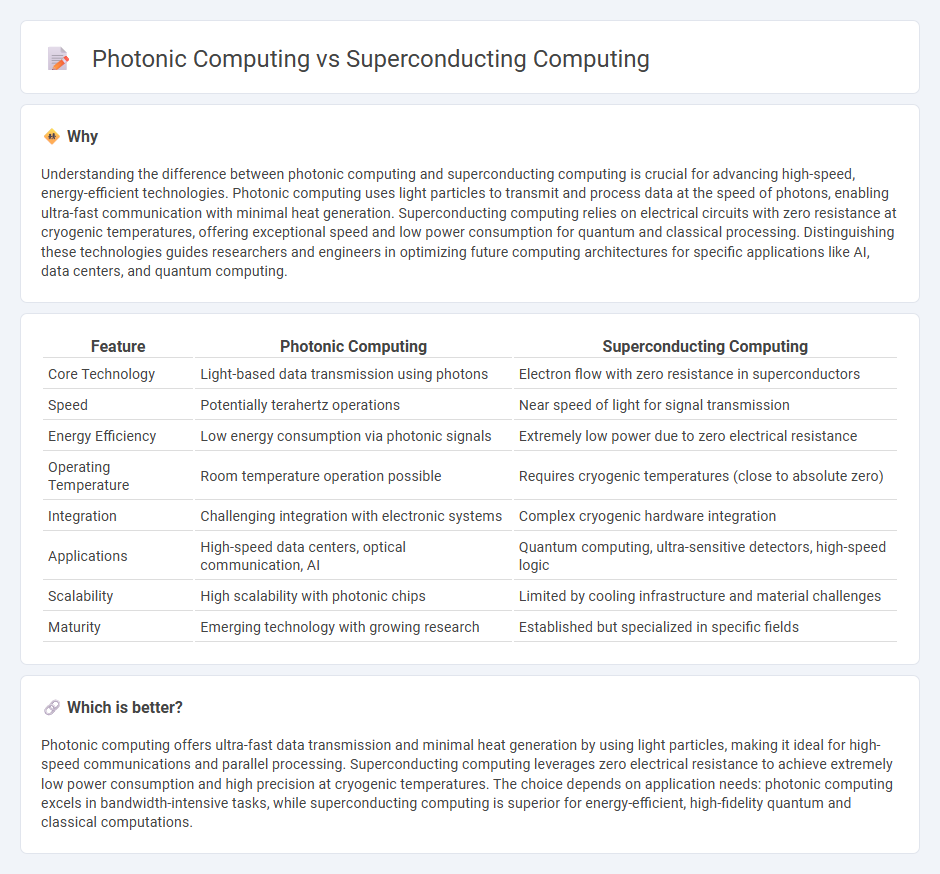
Photonic computing leverages light particles to process data at unprecedented speeds with minimal heat generation, enhancing energy efficiency and bandwidth compared to traditional electronic systems. Superconducting computing utilizes materials that exhibit zero electrical resistance at ultra-low temperatures, enabling extremely fast and energy-efficient signal transmission for advanced quantum and classical computing applications. Explore the distinctions and future potentials of these cutting-edge technologies to understand their impact on computing evolution.
Why it is important
Understanding the difference between photonic computing and superconducting computing is crucial for advancing high-speed, energy-efficient technologies. Photonic computing uses light particles to transmit and process data at the speed of photons, enabling ultra-fast communication with minimal heat generation. Superconducting computing relies on electrical circuits with zero resistance at cryogenic temperatures, offering exceptional speed and low power consumption for quantum and classical processing. Distinguishing these technologies guides researchers and engineers in optimizing future computing architectures for specific applications like AI, data centers, and quantum computing.
Comparison Table
| Feature | Photonic Computing | Superconducting Computing |
|---|---|---|
| Core Technology | Light-based data transmission using photons | Electron flow with zero resistance in superconductors |
| Speed | Potentially terahertz operations | Near speed of light for signal transmission |
| Energy Efficiency | Low energy consumption via photonic signals | Extremely low power due to zero electrical resistance |
| Operating Temperature | Room temperature operation possible | Requires cryogenic temperatures (close to absolute zero) |
| Integration | Challenging integration with electronic systems | Complex cryogenic hardware integration |
| Applications | High-speed data centers, optical communication, AI | Quantum computing, ultra-sensitive detectors, high-speed logic |
| Scalability | High scalability with photonic chips | Limited by cooling infrastructure and material challenges |
| Maturity | Emerging technology with growing research | Established but specialized in specific fields |
Which is better?
Photonic computing offers ultra-fast data transmission and minimal heat generation by using light particles, making it ideal for high-speed communications and parallel processing. Superconducting computing leverages zero electrical resistance to achieve extremely low power consumption and high precision at cryogenic temperatures. The choice depends on application needs: photonic computing excels in bandwidth-intensive tasks, while superconducting computing is superior for energy-efficient, high-fidelity quantum and classical computations.
Connection
Photonic computing and superconducting computing both aim to enhance computational speed and energy efficiency by leveraging unique physical properties--photons for data transmission and superconductors for zero-resistance electrical flow. Integration of these technologies enables ultrafast information processing with minimal energy loss, as superconducting materials can facilitate ultra-low latency photonic circuits. This synergy is pivotal in advancing next-generation computing architectures for quantum information systems and high-performance data centers.
Key Terms
Zero Electrical Resistance (Superconductivity)
Superconducting computing leverages zero electrical resistance in superconductors to enable ultra-efficient, high-speed signal transmission with minimal energy loss, significantly enhancing performance for complex computations. Photonic computing, while excelling in high-bandwidth optical signal processing and parallelism, relies on light rather than electrical resistance properties, thus exhibiting fundamentally different mechanisms for efficiency improvements. Explore deeper into how zero electrical resistance fundamentally transforms computational paradigms in superconducting technology.
Photons (Light-based Data Transmission)
Photonic computing leverages photons for data transmission, enabling ultra-fast signal propagation and significantly reduced heat generation compared to traditional electronic systems. Unlike superconducting computing, which relies on electrons and requires extremely low temperatures to achieve near-zero electrical resistance, photonic systems can operate at room temperature with minimal energy loss. Explore the advancements in photonic computing to understand how light-based data transmission is revolutionizing high-speed, energy-efficient computational technologies.
Cryogenic Cooling (Superconducting Systems)
Superconducting computing relies heavily on cryogenic cooling to maintain quantum coherence and minimize resistance in superconducting materials, typically operating at temperatures near 4 Kelvin using liquid helium or closed-cycle cryocoolers. Photonic computing, in contrast, generally functions effectively at or near room temperature, reducing the complexity and energy costs associated with extreme cooling systems. Explore more about how cryogenic cooling influences the performance and scalability of superconducting versus photonic computing technologies.
Source and External Links
Superconducting Quantum Computing: The Future of Qubits - SpinQ - Superconducting quantum computing systems use superconducting circuits to create and control qubits with zero electrical resistance at ultra-low temperatures, enabling fast gate operations and scalability favored by major tech companies like IBM and Google.
Superconducting quantum computing - Wikipedia - This field implements superconducting circuits as qubits, with research focusing on increasing the number of controllable qubits, and has achieved milestones such as Google's 53-qubit quantum supremacy demonstration.
Superconducting computing - Wikipedia - Superconducting computing uses zero-resistance superconductive circuits for improved power efficiency, enabling ultrafast operations with low heat dissipation, but requires cryogenic temperatures and faces integration challenges like cryogenic memory development.
 dowidth.com
dowidth.com